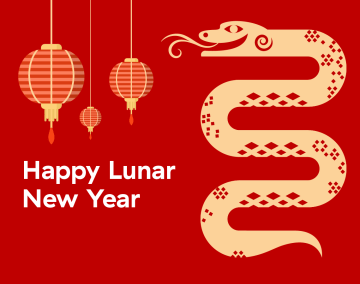Lunar New Year activities
Celebrate the year of the snake with activities for K-7.
- Grades K-7
- 2 activities
- 1 hour

Big idea
Learn about Lunar New Year, cultural traditions, the moon, and energy through fun limited-edition activities: Phases of the moon colouring (K-3) and Mahjong Match tiles (Grades 4-7).
Learning objectives
- Get to know the origins and meaning of Lunar New Year
- Learn about the cultural significance of related symbols and traditions
- Learn the scientific and mythological origins of lunar observations
- Connect learning about Lunar New Year and its cultural roots to the B.C. curriculum for elementary grade levels
Activities
BC curriculum fit
Learning about the significance of Lunar New Year in different cultures and how our connection to land, sea, and sky connects the personal and social throughout different communities in British Columbia.
Core Competencies:
Personal and Social, Thinking
- Understanding relationships and cultural contexts.
- Building relationships.
- Valuing Diversity
- Creating and Innovating
English Language Arts
Big Ideas:
- Exploring stories and other texts helps us understand ourselves and make connections to others and to the world.
- Exploring and sharing multiple perspectives extends our thinking.
Curricular Competencies:
- Identify how stories in First Peoples cultures connect people to land.
- Synthesize ideas from a variety of sources to build understanding.
- Demonstrate awareness of the oral tradition in First Peoples cultures and the purposes of First Peoples texts.
- Recognize and appreciate the role of story, narrative, and oral tradition in expressing First Peoples perspectives, values, beliefs, and points of view
Science
Big Ideas:
- Plants and animals have observable features
- Observable patterns and cycles occur in the local sky and landscape.
- Wind, water, and ice change the shape of the land.
Curricular Competencies:
- Demonstrate curiosity and a sense of wonder about the world
- Recognize First Peoples stories (including oral and written narratives), songs, and art, as ways to share knowledge
- Make predictions based on prior knowledge
- Identify First Peoples perspectives and knowledge as sources of information
Mathematics
Big Ideas:
- Regular changes in patterns can be identified and represented using tools and tables.
Curricular Competencies:
- Develop, demonstrate, and apply mathematical understanding through play, inquiry, and problem solving
- Visualize to explore mathematical concepts
Social Studies
Big ideas:
- Stories and traditions about ourselves and our families reflect who we are and where we are from.
- Healthy communities recognize and respect the diversity of individuals and care for the local environment.
- Canada is made up of many diverse regions and communities.
- Learning about Indigenous peoples nurtures multicultural awareness and respect for diversity.
- People from diverse cultures and societies share some common experiences and aspects of life.
Curricular competencies:
- Use Social Studies inquiry processes and skills to ask questions; gather, interpret, and analyze ideas; and communicate findings and decisions
- Contribute to a class collection of information on a common topic.
- Collect information from personal experiences, oral sources, and visual representations.
- Explain the significance of personal or local events, objects, people, or places
- Research the history of a significant event or person in the history of your community.
- Explore different perspectives on people, places, issues, or events in their lives (perspective)
- Explain why people’s beliefs, values, worldviews, experiences, and roles give them different perspectives on people, places, issues, or events
Assessments
Each activity includes tips on how to assess student engagement and success in the activity.
Background info
Lunar New Year and its calendars
While the Gregorian calendar is the internationally accepted calendar, it is a solar calendar based on 365-days of the year. A solar calendar uses the position of the Earth in relation to the sun to determine the dates of the year.
The Lunar New Year follows the phases of the moon and the sun, called a lunisolar calendar. This connection reflects the traditional Asian method of timekeeping, where months are based on the lunar cycle, and years align with both lunar and solar cycles.
There are approximately 40 different calendars still in use today, including the Hebrew and Hindu lunisolar calendars which combines solar cycles. In contrast, the Islamic calendar uses a lunar calendar, relying solely on the moon's phases to determine months and years.
What are Lunar Phases?
The lunar phases refer to the changing appearances of the Moon as observed from Earth due to its position relative to the Earth and the Sun. The main lunar phases include:
These phases are a result of the Moon's orbit around the Earth and the changing angles of sunlight falling on its surface. Reference for moon phases from National Geographic for Kids: https://www.natgeokids.com/uk/discover/science/space/the-phases-of-the-moon/
The Moon's effects and tidal energy
The gravitational pull of the Moon significantly influences Earth's tides. During a full moon and a new moon, when the Sun, Earth, and Moon are aligned, the gravitational forces combine, leading to higher high tides known as "spring tides." Conversely, during the first and third quarters of the moon, when the Sun and Moon are at right angles relative to the Earth, the gravitational forces partially cancel out, resulting in lower high tides known as "neap tides".
The tidal movement generates kinetic energy that can be harnessed for renewable energy. Tidal energy systems, often located in areas with strong tidal currents, use the ebb and flow of tides to turn turbines and generate electricity. This renewable energy source provides a predictable and consistent power supply, making it a promising component of the global effort to transition to sustainable energy.
Adaptions/modifications
To create a longer lesson plan, find information about the moon's phases, Lunar New Year's history, and how it's celebrated in different Asian cultures, and have a discussion about them before starting the activity. There are many video resources available, including some linked within the activities.






